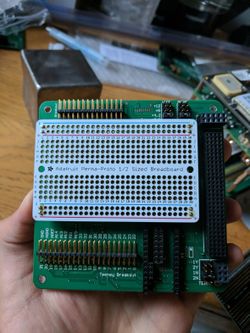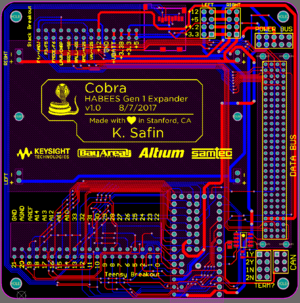Difference between revisions of "Balloons Gen 1 Expander"
| Line 103: | Line 103: | ||
=== Stack Pinout === | === Stack Pinout === | ||
| − | [[File:Cobra3. | + | [[File: Cobra3.png | right| thumb | <center> Cobra Routing </center>]] |
There is, additionally, a smaller pinout for the HONEY stack -- providing access to all of the most important data and power lines in the HONEY stack. Due to lack of space on the interior of Cobra, this breakout faces the exterior edge. | There is, additionally, a smaller pinout for the HONEY stack -- providing access to all of the most important data and power lines in the HONEY stack. Due to lack of space on the interior of Cobra, this breakout faces the exterior edge. | ||
Latest revision as of 21:11, 28 September 2017
| Cobra | |
|---|---|
| Part of the HONEY Architecture series & the HABEES series | |

| |
| Chief Designer | Kirill Safin |
| Technology Line | Balloons Expanders |
| Version | Generation I |
| Name | Cobra |
| General | |
| HONEY Standards • Venom Breakout • Fang Breakout • Board Naming | |
| Core Software | |
| STINGR | |
| Core Avionics | |
| The Count | |
| Core Power | |
| Biscuit | |
| Core Peripherals | |
| Cobra • Viper • ProtoBee | |
| Core Radio | |
| Macaw | |
| Test & Prototype | |
| QueenBee | |
| Guides | |
| Making a HONEY Board • Using STINGR • Using QueenBee • Making a Prototype | |
| V • E | |
Cobra is the first generation of HABEES HONEY Expander Boards. Expander Boards ae HONEY-compliant boards that allow expanding the capabilities of a HONEY flight stack in a rapid-prototyping manner. That is, one can test new circuits or projects readily in a HONEY flight stack without making a HONEY compliant board.
Cobra provides this capability by allowing one to slot in a 1/2 size Adafruit Perma-protoboard (a half-size solderable breadboard) as well as an optional Teensy 3.2. This allows one to very quickly attempt a project or circuit and fly it in a full-fledged HONEY flight stack.
Operation
Cobra has a number of useful features aboard to make prototyping & integration easy. The following sections highlight these capabilities, how they work, and how to use them.
ProtoBoard Mating
The majority of the board is left blank to permit plugging-in the 1/2 size protoboard. The protoboard plugs in to a set of 2x1 sockets at each corner of the protoboard -- at each extreme end of both power rails. The protoboard must have a matching set of male connectors to mate with the sockets.
The sockets in question, and the appropriate mating connectors, are: Sockets: Samtec SL-12-G-10 Headers: Samtec BBL-12-G-E
For mating with Cobra, a protoboard must have these header connectors soldered in the appropriate four corners, to enable mating.
ProtoBoard Power
After mating the ProtoBoard to Cobra, one can select the voltages applied to each of the power rails automatically by Cobra -- by using a pair of jumpers at the power selection headers in the top right of the board.
Simply apply a jumper between the desired voltage (provided by the HONEY stack or the on-board Teensy). The provided voltages are +5, +4.2 (raw battery), +12, and +3.3 (this 3.3V is from the on-board optional teensy, NOT the HONEY bus).
Be certain to not jump more than one voltage on a given rail -- this could cause permanent damage to the BMS or Teensy. You may select different voltages for each of the power rails, if desired (ie +5 on one, +12 on the other), or you can set the same voltage source for both.
The shunt used is the Samtec SNT-100-BK-G (0.100" Shunt). The headers themselves are Samtec TSW-14-07-G-D
MCU Socket
If the circuit or project being tested requires a microcontroller, Cobra is equipped with a socket for an optional Teensy 3.2 device. Even more conveniently, this socket breaks out all of the Teensy pins into a convenient right-angle standard pitch set of headers. One can easily, then, tap into a teensy pin and connect it to the protoboard by using a female-male jumper cable.
The right-angle header strip is at a right angle as opposed to straight up (as is usual) because of clearance limitations. A standard HONEY board has 15mm of vertical clearance, while a female header cable itself is at least 1 cm at its base. By making the breakout right-angled, header cables can be used in this slim profile.
The Teensy socket, if used, also comes with an included MicroSD socket for data logging (at the top of the board), and a CAN Transceiver, for interfacing with the HONEY stack. The implementation of these, however, results in the utilization of Teensy pins 3 & 4 (for CAN) and one for the microSD chip-select. These pins, are, therefore, off-limits for use as they are already reserved for these functionalities.
The socket is comprised of the following parts: SDL-17-G-10 (long 2-row part) SL-114-G-10 (2 side parts) SL-15-G-10 (back part) SL-13-G-10 (analog pins part)
And the mated teensy side has these headers:
BBL-114-G-E BBL-15-G-E BBL-13-G-E
The breakout for the Teensy pin right-angled header is as so, with the first row being the top row, and the second row being the bottom row; left to right as viewd down the Cobra PCB from the top.
The right-angle connector used is the Samtec TSW-120-08-G-D-RA.
| 0 | 1 | 2 | 5 | 6 | 7 | 8 | 9 | 10 | 11 | 12 | 13 | 14 | 15 | 16 | 17 | 18 | 19 | 20 | 21 |
| 22 | 23 | 24 | 25 | 26 | 27 | 28 | 29 | 30 | 31 | 32 | 33 | A10 | A11 | A12 | A13 | A14 | AREF | AGND | GND |
Stack Pinout
There is, additionally, a smaller pinout for the HONEY stack -- providing access to all of the most important data and power lines in the HONEY stack. Due to lack of space on the interior of Cobra, this breakout faces the exterior edge.
It is worth noting that this connector breaks out the Teensy 3.3V (+3.3), as well as the HONEY Power Bus 3.3V (+3.3 BUS). This allows using +3.3 from the teensy without utilizing the power-rail voltage selectors, and also allows using +3.3V without a Teensy (by using the bus supply).
For understanding of all other pins and their function, reference the HONEY spec.
The breakout of these pins is as so, with the first row being the top row, and the second row being the bottom row, shown left-to-right, as seen looking at the connector down the board from the top.
The connector used is the Samtec TSW-114-08-G-D-RA
| 5V | 3.3V | 3.3V BUS | VBATT (4.2V) | GND | 12V | VADJ_PWM | R_MCU | R_ALL | S_READY | LOW_PWR | FMODE | F3 | F4 |
| 5V | 3.3V | 3.3V BUS | VBATT (4.2V) | GND | 12V | (-12 S) | (+12 S) | (-5 S) | (+5 S) | CHIRP | F6 | F5 | VADJ OUT |
